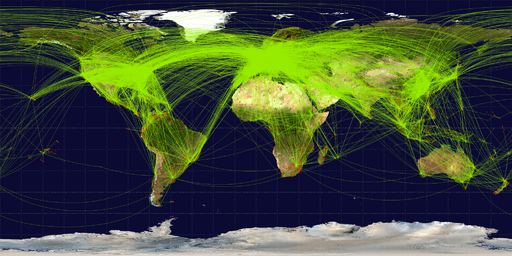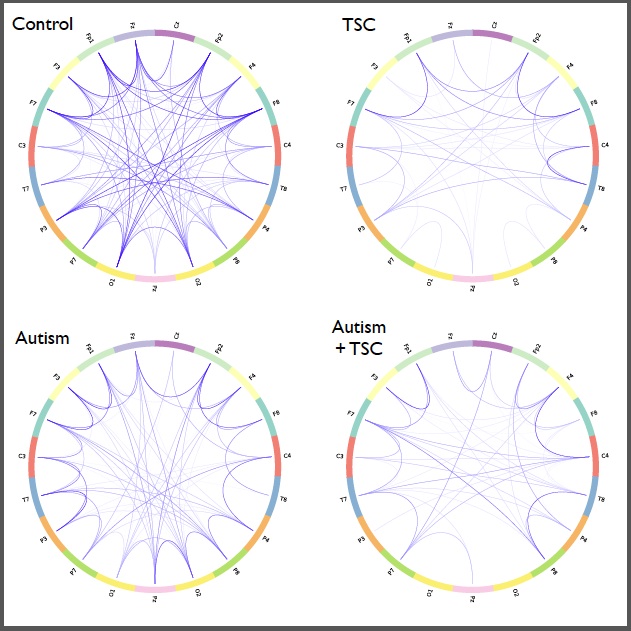Ed note: The Obama administration is expected to unveil plans for a decade-long Brain Activity Map project next month. This is Part One of a two-part series on brain mapping.

How is information routed in the brains of children with autism? (Image: Jpatokal/Wikimedia Commons)
It’s now pretty well accepted that autism is a disorder of brain connectivity—demonstrated visually with advanced MRI techniques that can track the paths of nerve fibers. Recent exciting work analyzing EEG recordings supports the idea of altered connectivity, while suggesting the possibility of a diagnostic test for autism.
But what’s happening on a functional level? A study published this week zooms out to take a 30,000-foot view, tracking how the brain routes information in children with autism—in much the way airlines and electrical grids are mapped—and assessing the function of the network as a whole.
“What we found may well change the way we look at the brains of autistic children,” says investigator Jurriaan Peters, MD, of the Department of Neurology at Boston Children’s Hospital.
Peters and Maxime Taquet, a PhD student in the hospital’s Computational Radiology Laboratory, analyzed EEG recordings from 19 different brain regions to track the brain’s electrical cross-talk. They studied two groups of autistic children: 16 with classic autism and 14 whose autism is part of a genetic syndrome known as tuberous sclerosis complex (TSC). They compared these readings with EEGs from two control groups—46 healthy neurotypical children and 29 children with TSC but not autism.
The above image, generated by Taquet and Peters and published in BioMed Central, gives a snapshot of the findings. The 19 brain areas where electrodes were placed are arranged on the periphery of each circle according to their proximity to each other. Compared with neurotypical controls, both groups of children with autism spectrum disorders (ASDs) have multiple redundant connections between adjacent brain areas, but fewer connections going across, linking far-flung areas. (Both groups with TSC show sparser connections overall; those with TSC and ASD have a “double hit.”)
Seeing the big picture
So what does it mean to have a brain network that favors short-range over long-range connections? It’s a pattern that seems consistent with autism’s classic cognitive profile. Think of a child who excels at specific, focused tasks like memorizing streets, but who can’t integrate information across different brain areas into higher-order concepts.
“A child with autism may not understand why a face looks really angry, because his visual brain centers and emotional brain centers have less cross-talk,” Peters speculates. “The brain cannot integrate these areas. It’s doing a lot with the information locally, but it’s not sending it out to the rest of the brain.”
“The brain’s doing a lot with the information locally, but it’s not sending it out to the rest of the brain.”
Using the language of network wonks, Peters and Taquet observed “resilience” in the brains of the children with autism—the ability to find multiple ways to get from point A to point B through redundant pathways. “Much like you can still travel from Boston to Brussels even if London Heathrow is shut down, by going through New York’s JFK airport for example, information can continue to be transferred between two regions of the brain of children with autism,” says Taquet.
Sounds good, right? But, Taquet continues, “In such a network, no hub plays a specific role, and traffic may flow along many redundant routes.”
While good for an airline, resilience may indicate a brain that responds in the same way to many different kinds of situations and is less able to focus on the stimuli that are most important. It’s consistent with cellular and molecular evidence for decreased “pruning” of brain connections in autism.
“It’s a simpler, less specialized network that’s more rigid, less able to respond to stimulation from the environment,” says Peters.
Here’s Peters presenting the work in detail at the 2012 Autism Consortium meeting:
Under a recently announced Autism Center of Excellence Grant from the National Institutes of Health, Peters and colleagues will repeat their analysis, taking EEG recordings prospectively under uniform conditions.
Meanwhile, parallel work suggests that it might be possible to alter autism networks. A team at Cincinnati Children’s Hospital has shown that treatment with Afinitor (everolimus) improves brain connectivity in people with TSC, as indicated by advanced MRI images of brain architecture. And a clinical trial, conducted by Boston Children’s neurologist Mustafa Sahin, MD, PhD, with the Cincinnati team, may soon tell us whether Afinitor improves cognition and features of autism.
Part Two of the series next week will look at fetal brain mapping.








